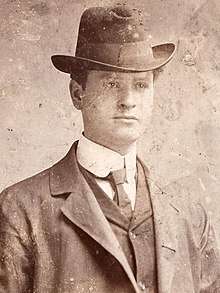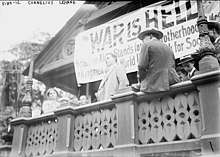Con Lehane (socialist)
Cornelius "Con" Lehane (also spelled O'Lyhane) (1877–31 December 1919) was a socialist active in the Irish Socialist Republican Party, the Social Democratic Federation, and the Socialist Party of Great Britain.
Con Lehane | |
|---|---|
 Lehane, c. 1905 | |
| Born | 1877 |
| Died | 31 December 1919 |
| Occupation | Clerk |
| Political party | Socialist Party of Great Britain (1904-1906) |
| Movement | World Socialist Movement |
Ireland
Lehane was born in Coachford, County Cork in 1877. Although a graduate in Irish and chemistry from the Cork Technical School, by profession Lehane was a clerk (cf. E. J. B. Allen). Like Valentine McEntee, Lehane had been a member of James Connolly’s Irish Socialist Republican Party and indeed was one of the dozen or so most important members. As ‘Proletarian’ he wrote many articles for the ISRP journal, The Workers Republic, and designed the front cover for the ISRP’s Workers’ Republic pamphlet series. (He may well have designed the cover of the SPGB’s first pamphlet, which is carried out in a similar fashion). O’Lyhane, as he was then known, was the moving force behind the Cork branch (1897–1902). He clashed with Connolly over the latter’s attempts to mollify Catholic opinion by a ban on religious discussion within the party. In 1902 as a result of his uncompromising atheism he was denounced from the pulpit and lost his job.
Lehane is described as "the colourful and brash ISRP organiser in Cork. Young, energetic and with a strong grasp of socialist politics," by the historian of the ISRP, David Lynch. David Lynch devotes almost a chapter in his book about the ISRP to Con Lehane, Radical Politics in Modern Ireland A History of the Irish Socialist Republican Party 1896-1904. .[1]
Britain
He then moved to England, joining the Social Democratic Federation around the turn of the century.

Lehane eventually left the SDF and was a founding member of the Socialist Party of Great Britain in 1904. He was the first General Secretary of the SPGB (June 1904 to August 1905) and was a prominent public speaker for the Party. He was expelled along with most of the rest of Islington branch on 18 September 1906. His downfall came as follows. At the 1906 Annual Conference Bexley branch tabled a motion calling on the party to adopt a policy of socialist industrial unionism. This was voted down and charges brought against the branch. They were eventually expelled but Islington branch, led by Lehane, argued that the question should never have arisen and demanded that the Executive Committee should be removed for not rescinding the Bexley resolution and refusing to alter the record of the resolution. Islington ceased activity when this did not happen. Charges were hence brought against the branch. After being expelled the group continued to meet for a while as Islington branch of the SPGB and published two pamphlets (Rocks Ahead and Another Political Wreck) both signed by Lehane and his branch.
Some time after leaving the SPGB he emigrated to the U.S., where in 1913 he cooperated with Jim Larkin. The SPGB noted his presence there in 1915.[2] In 1917 he was jailed for his opposition to the war. He died on 31 December 1919 in a New York City hospital shortly after being released from prison.
Further reading
- Radical Politics in Modern Ireland: A History of the Irish Socialist Republican Party (ISRP) 1896-1904 David Lynch, Dublin, Irish Academic Press 2005. ISBN 0-7165-3356-1.
- Noted Socialist Here: Cornelius Lehane of Ireland, Speaks in Lyceum Theatre This Afternoon. The Gazette Times, September 6, 1914, §2, p. 4
References
- Radical Politics in Modern Ireland- A History of the Irish Socialist Republican Party 1896-1904 (Irish Academic Press), David Lynch, pp. 21
- Socialist Standard, December 1915
- Socialist Party of Great Britain 1904–1913 membership register
- Justice
External links
| Wikimedia Commons has media related to Con Lehane. |